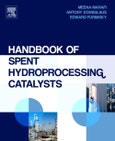This handbook serves scientists and researchers interested in any aspect of spent hydroprocessing catalysts. Its aim is to assist in the analysis and assessment of refined catalyst byproducts and processing options, to determine whether spent catalysts can be processed into productive resources. For non-regenerable spent catalysts, the book takes into consideration both safety and ecological implications of utilizing landfill and other waste options.
- Provides comprehensive guidance and assistance to those making decisions on the fate of spent catalysts, radically improving strategic options for refining organisations
- Offers solutions that maximize procedural, regulatory, safety, and preparedness benefits
- Contains detailed information on hazardous characteristics of spent and regenerated catalysts with deployment recommendations, and acts as a benchmark document for establishing threshold limits of regulated species as well as for developing procedures for handling spent catalysts to ensure environmental acceptance
Table of Contents
1. Introduction 2. Developments in Petroleum Refining 3. Hydroprocessing of Petroleum 4. Catalyst Deactivation 5. Environmental and Safety aspects of spent Hydroprocessing Catalysts 6. Regeneration 7. Rejuvenation 8. Cascading 9. New Catalysts from Spent Catalysts 10. Preparation of Useful Materials from Spent Catalysts 11. Spent Catalysts from Dewaxing 12. Metal Reclamation from Spent Catalysts 13. Markets and Price trends for Metals in Spent Hydroprocessing Catalysts 14. Future Perspectives 15. References








